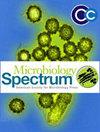在儿童中验证 Diabetomics CovAB SARS-CoV-2 抗体检测:与血清学的比较。
摘要
监测抗体流行率是评估社区严重急性呼吸系统综合症冠状病毒 2(SARS-CoV-2)负担、确定风险因素以及评估临床和公共卫生干预策略影响的重要工具。美国疾病控制和预防中心利用各种来源的血清流行率估计,2022 年初美国儿童的 SARS-CoV-2 抗体流行率为 74.2%。新泽西州卫生部在 2022 年底/2023 年初对未接种疫苗的儿童进行的一项研究发现,使用牙龈拭子检测抗体的流行率较低,为 68%。这项研究比较了牙龈拭子法检测抗体的准确性,以及在更多儿童中同时获取血清样本的准确性。这项横断面研究招募了未接种 SARS-CoV-2 疫苗、年龄在 18 个月至 11 岁之间的健康儿童,他们被安排在市内一所大学的儿科诊所进行常规血液检查。在征得家长同意后,额外采集了 5 cc 血液和牙龈拭子样本。比较了 Diabetomics CovAb SARS-CoV-2 牙龈拭子抗体检测和罗格斯新泽西医学院酶联免疫吸附试验血清学尖峰蛋白抗体检测的结果。使用 McNemar 检验、Cohen's kappa 统计量和其他诊断准确性统计量对这些配对样本的血清阳性率进行了比较。从 2023 年 6 月到 8 月,共招募了 86 名儿童。牙龈拭子抗体阳性率为 70.9%,血清学阳性率为 87.2%。科恩卡帕统计量为 0.39,表明一致性极低,McNemar 检验具有显著性(P 值为 0.0010)。与血清学相比,牙龈拭子的敏感性为 78.7%(95% CI 68.7% 至 87.3%),特异性为 81.8%(95% CI 48.2% 至 97.7%)。阳性和阴性预测值分别为 97.5% 和 29.9%,准确率为 79.0%。非西班牙裔儿童与西班牙裔儿童的灵敏度分别为 74.2% 和 82.5%,6-11 岁儿童与 18 个月至 5 岁儿童的灵敏度分别为 74.2% 和 81.8%。虽然牙龈拭子法检测抗体的灵敏度和特异性不如血清学,但可以在无法进行抽血的情况下采集样本。这种方法可用于非临床环境,如监测、评估流行病学趋势和关联:最近,一项研究确定了新泽西州未接种疫苗儿童的严重急性呼吸系统综合征冠状病毒 2(SARS-CoV-2)抗体流行率(Katic et al.https://2023.pas-meeting.org/searchbyposterbucket.asp?bm=Public+Health+%26+Prevention&t=Public+Health+%26+Prevention&pfp=Track )采用牙龈拭子法进行抗体检测。Diabetomics CovAB 测试可定性鉴定 SARS-CoV-2 尖峰蛋白抗体,是一种便于儿童使用的低成本护理点测试。虽然该检测对成人的结果灵敏而特异[美国食品和药物管理局(FDA)。2022.设备和放射卫生中心。欧盟授权血清学检测性能。见 https://www.fda.gov/medical-devices/covid-19-emergency-use-authorizations-medical-devices/eua-authorized-serology-test-performance],但缺乏有关其在儿童中准确性的数据。作为上述研究的后续,我们比较了牙龈拭子检测和血清学抗体检测的结果。我们发现,牙龈拭子检测的结果不如血清学检测,但灵敏度和特异性相当高,阳性预测值也很高。虽然这种检测方法并不适合用于儿童诊断,但它可以成为公共卫生官员和儿科医生了解以往卫生干预措施程度的重要工具。Monitoring antibody prevalence is a valuable tool to evaluate the burden of severe acute respiratory syndrome coronavirus 2 (SARS-CoV-2) in a community, identify risk factors, and assess the impact of clinical and public health intervention strategies. The antibody prevalence of SARS-CoV-2 in children in the United States in early 2022 was estimated by the Centers for Disease Control and Prevention to be 74.2%, using seroprevalence from a variety of sources. A study by the New Jersey Department of Health in late 2022/early 2023 in unvaccinated children found a lower prevalence, 68% when using a gum swab method to detect antibodies. This study compared the accuracy of the gum swab method to detect antibodies with simultaneously obtained serological samples in additional children. This cross-sectional study recruited well children, not vaccinated for SARS-CoV-2, aged 18 months to 11 years, who were scheduled for routine bloodwork at an inner-city university-based pediatric clinic. With parental consent, an extra 5 cc of blood and a gum swab sample were collected. Results from Diabetomics CovAb SARS-CoV-2 gum swab antibody test and Rutgers New Jersey Medical School enzyme-linked immunosorbent assay serology test for spike protein antibody were compared. The seropositivity of these paired samples was compared using McNemar's test, Cohen's kappa statistic, and other diagnostic accuracy statistics. From June through August 2023, 86 children were recruited. Antibody positivity by gum swab was 70.9% and by serology was 87.2%. The Cohen's kappa statistic was 0.39 indicating minimal agreement and McNemar's test was significant (P-value of 0.0010). Compared with serology, gum swab was 78.7% sensitive (95% CI 68.7% to 87.3%) and 81.8% specific (95% CI 48.2% to 97.7%). Positive and negative predictive values were 97.5% and 29.9%, respectively, and accuracy was 79.0%. Sensitivity in non-Hispanic versus Hispanic children was 74.2% versus 82.5%, and in children 6-11 years versus 18 months to 5 years, it was 74.2% versus 81.8%. While the gum swab method of antibody detection is not as sensitive or specific as serology, sample collection can be done in settings where phlebotomy is not feasible. This method could be useful in non-clinical settings such as surveillance, for assessing epidemiological trends and associations.
Importance: Recently a study determining the prevalence of severe acute respiratory syndrome coronavirus 2 (SARS-CoV-2) antibodies in unvaccinated children in NJ (Katic et al. 2023. Pediatric Academic Societies Meeting; Washington, D.C. https://2023.pas-meeting.org/searchbyposterbucket.asp?bm=Public+Health+%26+Prevention&t=Public+Health+%26+Prevention&pfp=Track) was conducted using a gum swab method for antibody detection. The Diabetomics CovAB test, which qualitatively identifies antibodies to SARS-CoV-2 spike protein, is a point-of-care, low-cost test, that is easy to administer in children. While this test provides sensitive and specific results in adults [US Food and Drug Administration (FDA). 2022. Center for devices and radiological health. EUA authorized serology test performance. Available from: https://www.fda.gov/medical-devices/covid-19-emergency-use-authorizations-medical-devices/eua-authorized-serology-test-performance], data on its accuracy in children is lacking. As a follow-up to the above-mentioned study, we compared the results of the gum swab test to a serologic antibody test. We found that the gum swab test was inferior to serology but was fairly sensitive and specific with a high positive predictive value. While the test is not ideal for diagnostic purposes in children it can be a valuable tool for public health officials and pediatricians to understand the extent of past health interventions.

 求助内容:
求助内容: 应助结果提醒方式:
应助结果提醒方式:


